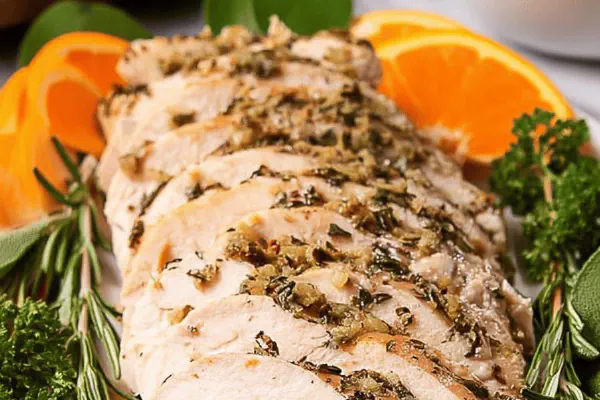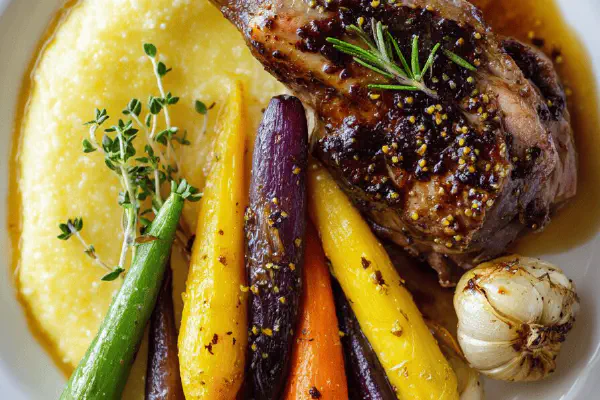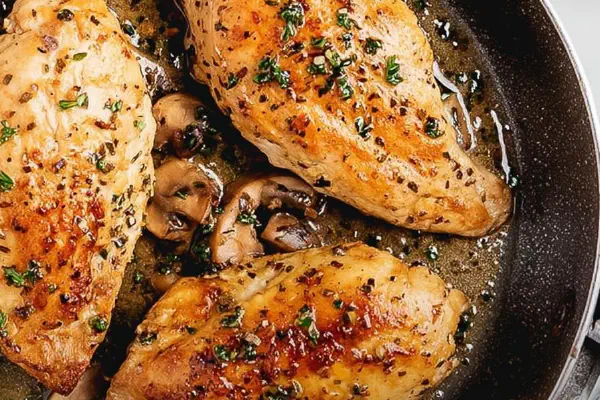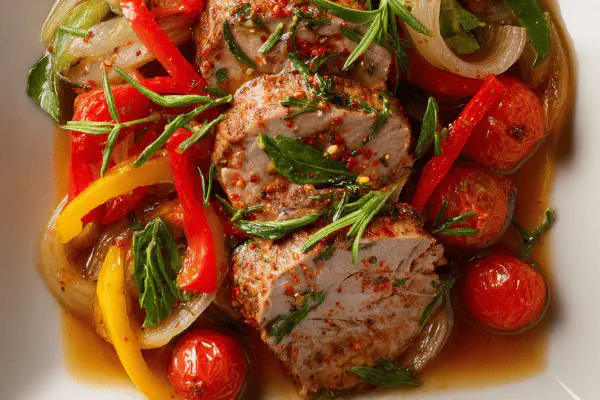Featured Recipe
Lamb Leg with Herb Crust and Rosemary Jus
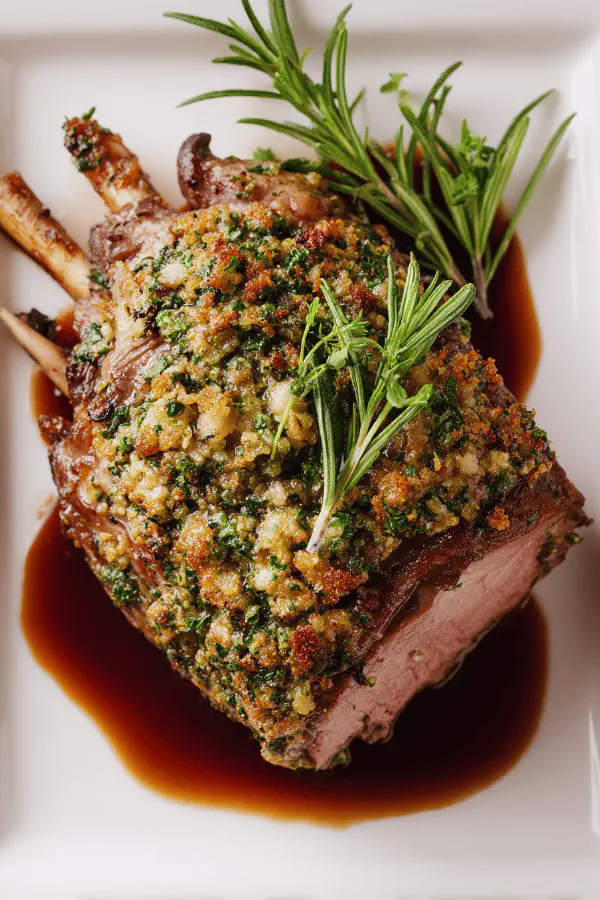
By Kate
"
Boneless leg of lamb roasted with a garlic-parsley crust infused with fresh tarragon and sage instead of rosemary and thyme. Served with a reduced red wine and beef broth jus scented with lemon zest and a sprig of rosemary for perfume. Adjusted water quantity. Roasting starts hot to seal juices then lowered for even cooking. Internal temp guides doneness. Pan juices strained for a glossy sauce. Substitutions for herbs and liquids included. Practical tips on handling bones and cracking the crust. Timing flexible with sensory cues to avoid dry meat or bitter sauce.
"
Prep:
25 min
Cook:
Total:
Serves:
8 servings
lamb
roast
gourmet
herbs
dinner
Introduction
Lamb leg, boned and rolled, thickly coated with a coarse garlic and herb crust. Roast hot, then lower temp to develop crust and cook through. Bones scattered around yield flavor, moisture, and aromatic complexity in pan drippings. That crust isn’t just texture; it acts like a moisture barrier, locks in tangy mustard and herbs. Aim for medium rare—internally warm, still translucent. Juices in pan transform with beef stock and red wine, simmered gently with a fresh sprig of rosemary and lemon zest, finishing with a weave of fragrance and balance. Forget rigid times. Watch the crust’s golden edge, listen for sizzles, track color changes. The aroma changes from sharp garlic to mellowed herbs and roasted meat signals when to lower heat or pull lamb out. Perfect roast changes atmosphere. Sharp and tender. It’s a little ritual. And if you haven’t got lamb bones, pork or beef ribs can stand in—roast first to brown, crack the flavor. Swapping rosemary for tarragon and sage brings unexpected herbal notes. Moutarde de Dijon replaced by grainy mustard to add texture in the crust. All these tweaks dial the flavor differently and let you accommodate what’s in your pantry.
Ingredients
About the ingredients
Italian-style breadcrumbs bring crunch and absorb moisture but can be swapped for homemade panko or even crushed toasted walnuts if nut allergies don’t apply. The egg binds the crust; no substitute for texture there, but a thin brush of cream or yogurt can help if preferred. Instead of rosemary and thyme, fresh tarragon and sage add a more anise-like, earthy finish that cuts dense lamb fat well. Olive oil quality matters here: fruity, peppery will translate into final crust aroma. Moutarde de Dijon replaced with whole grain mustard to add pop and visual interest; smooth Dijon will still work but crust texture differs. Beef stock can be swapped with strong chicken stock or vegetable broth, but beef adds depth. If no red wine, a splash of aged balsamic or verjuice mixed with a touch of grape juice can mimic acidity and sweetness. Lemon zest in jus brightens and balances lamb richness. Keep lamb bones — roast separately if needed and add to roasting pan for flavor or make a quick stock with them later for sauces. Salt and pepper not just seasoning but enhance herb notes and crust development; don’t be shy. Garlic—fresh best. If you can’t tolerate raw garlic’s sharpness, fry it lightly first.
Method
Technique Tips
Start with the high heat roast to seal the crust and juices. If your crust isn’t browning by 15 minutes, rotate the pan or raise oven rack closer to heat source. Lower oven after crust is set to avoid burning and dry meat. Pour water around bones, not on crust — prevents steam inside but keeps drippings from sticking and burning. Add water during cooking as needed; listen to the popping and hissing sounds to gauge moisture levels. Cover with foil if crust threatens to darken too fast, but only loosely — trapped steam makes crust soggy. Internal temperature is your best doneness guide. A probe meat thermometer helps but if not available, press lamb with tongs — it should feel springy but not too soft for medium rare. Resting is critical. Slice thin against grain once rested; slice thick and meat pulls apart. Strain pan juices carefully, simmer gently with stock, wine, lemon zest, and rosemary sprig added last for freshness. Taste before serving; adjust salt and pepper. If sauce becomes grainy or oily, stir in a splash of hot water or stock to re-emulsify. Lamb bones ramp up pan sauce flavor; brown them beforehand if time allows to deepen richness. For crust, adjust thickness based on size of lamb piece and presence of fat. If crust seems soft or loose post-roast, broil briefly with close eye to finish. Avoid overcrowding pan and juices dilution as this flattens flavors. Make ahead: crust mix can be prepped day before; lamb can sit wrapped 2 hours before roasting at room temp to promote even cooking.
Chef's Notes
- 💡 High heat initially. Crucial for sealing in juices and forming that crust. If crust isn’t browning in about 15 minutes, rotate pan or adjust rack closer. Watch for sizzling sounds.
- 💡 Keep an eye on liquid levels in the pan. Add water gradually to prevent drying out. Fuels flavor from bones, and prevents drippings from burning. Around edges only. No soggy crust.
- 💡 Don’t skip resting time. Critical for juice redistribution. Slice thinly against grain. Sweet spot between tender and juicy. Timing isn’t rigid — trust the feel, watch texture.
- 💡 Mix chicken or veggie broth with beef if that’s what on hand. Experiment with ratios. Not every stock provides the same depth. Adjust flavors as needed.
- 💡 Broil briefly if crust feels soft post-roast. Keep a close watch. Quick finishing step can elevate texture. Avoid overcooked areas and burnt edges from heat.
Kitchen Wisdom
How to check doneness?
Use a probe or poke with tongs. Should feel springy, firm but not hard. Pull at 56-58°C for medium rare. Visual cues—internal color important.
What if crust isn’t setting?
Rotate pan or raise it closer to top heat. It needs browning after 15 minutes. Adjust temp as necessary; watch for sizzling.
Common issue with sauce?
If it separates, whisk in warm water or stock to re-emulsify. Avoid harsh boiling; should simmer gently for gloss. Adjust acidity with lemon.
Storage options?
Can chill leftovers. Slices wrapped well, freeze for later. Reheat slowly to avoid drying. Sauce also saves; reheat with splash of water for smooth texture.
